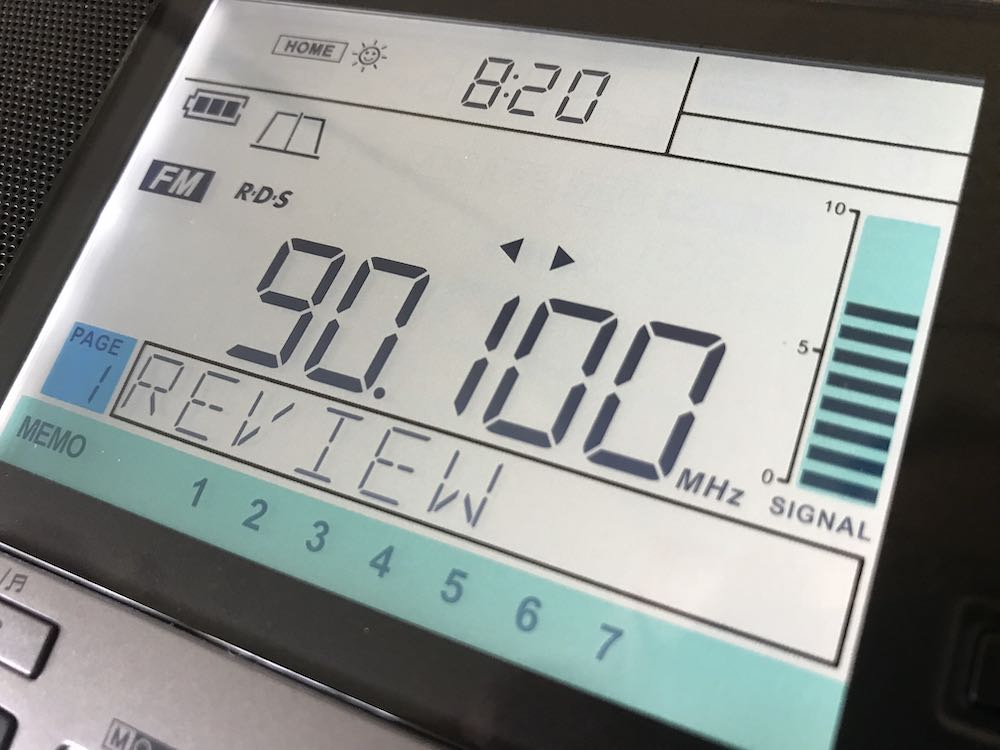 Many thanks to SWLing Post contributor, Dan Robinson, for the following guest post and review:
Many thanks to SWLing Post contributor, Dan Robinson, for the following guest post and review:
Sangean v Tecsun in the Battle of Late Shortwave Era Portables: The ATS909x2
by Dan Robinson
Some years ago – actually more than a decade – I decided to give Sangean a shot at winning me over in the shortwave portable category.
I had and still do use numerous portables with a bias toward the classic SONY, Panasonic, and Grundig sets. The ones that made an impression stayed, often in multiples, as anyone can see if they visit the radio shack here in Maryland.
These include, for those interested: the Panasonic RF-B65, SONY ICF-SW77, ICF-2010, ICF-PRO80, ICF-7600D, ICF-7700, ICF-SW1000T, ICF-SW55, ICF-SW100s, ICF-SW07, Grundig Satellit 500, to which were added in more recent times the Toshiba RP-F11, XHDATA D-808, and Tecsun portables ranging from the PL-365 and new PL-368 to the PL-880, PL-990x, H-501x, and S-8800.
Sangean has generally not been on that list. There’s a good reason – I just never considered Sangean to be competitive when it comes to portables, though they did have some excellent larger sets such as the ATS-803A that made the first forays into multiple bandwidth options.
My last experience with Sangean was with the ATS-909. I liked the looks and capabilities of that receiver, and even went to the point of having mine modified by Radio Labs. But those mods were underwhelming, in my view, and the original 909 always seemed to me to be deaf when using the whip antenna.
That issue continued unfortunately with the 909x. Some of you may have seen a video I did a few years ago in which I set a 909x against a SONY SW-07 and Panasonic RF-B65. This was done barefoot with only the whip antennas, but near a window. In short, the other two radios wiped the floor with the 909x.
It took a surprisingly long time for Sangean to update the 909x with the 909×2, during which companies asked valid questions about the need for further development of world band portables.
Eton turned the market on its head when it introduced the still superb E1/XM which competed with the very end of SONY portable production, and co-designed with R.L. Drake added such superb features as Passband Tuning and three selectivity positions.
Meanwhile, Tecsun plugged away, introducing an impressive array of portables including the PL-600 series, then the 880 and now the 990x and H-501 portables.
So, now the 909×2 is here and with its 073 firmware upgrade has become a bit of a holy grail for portable receiver users. There have been a number of excellent reviews, including Dave Zantow’s deep dive, and some others here on SWLing Post.
I’m going to give you my impressions, using the really detailed Zantow review as a base. I received my 909×2 from Amazon just today – it is a 073 firmware which confirms that new supplies have the upgrade.
SENSITIVITY ON WHIP
First, let’s get the elephant in the room out of the way. Although I have not undertaken detailed technical testing of the 909×2 – nor do I have the equipment to carry this out – it does seem that Sangean may have finally tackled this crippling flaw that rendered the old 909x nearly useless when using it only on the whip. I’ll undertake further testing and comparisons with some of my other portables to confirm this. The whip antenna itself is robust – solid and long, something that Tecsun could take note of.
AIR BAND
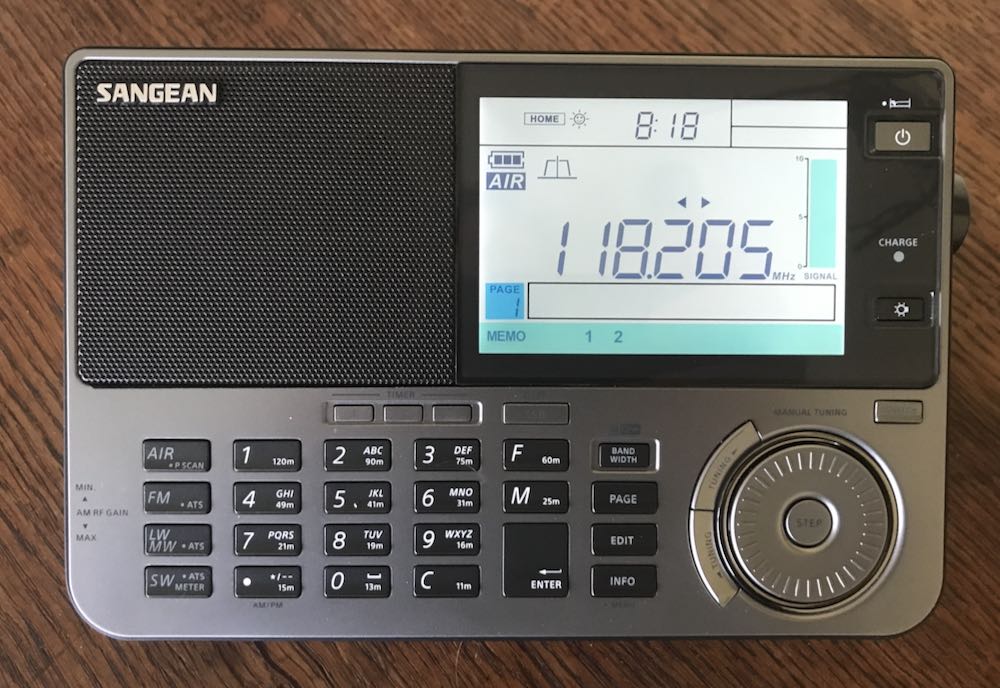 Inclusion of air band on this radio is a major selling point for those interested in this type of monitoring. My initial tests showed the 909×2 to be quite sensitive and useful – I managed to pick up no fewer than five airport comms frequencies in my area here in Maryland.
Inclusion of air band on this radio is a major selling point for those interested in this type of monitoring. My initial tests showed the 909×2 to be quite sensitive and useful – I managed to pick up no fewer than five airport comms frequencies in my area here in Maryland.
SELECTIVITY / AUTO-BANDWIDTH
The 909×2 really shines with FIVE available selectivity options that are easily selectable in shortwave mode. It would have been nice to be able to actually see the values of each filter as one scrolls through, but that’s a minor point. Think about it – in shortwave AM mode, this is the number of selectivity positions that one finds on such power house communication receivers as a Drake R8. Amazing that we now have that in a portable. On the negative side, I find the auto-bandwidth feature on the 909×2 to be nearly useless, as useless as the similar feature found on Tecsun receivers. The automatic switching is distracting and annoying. My advice to users: forget this, and stick with manual bandwidth control. My advice to Sangean – I wish they had left this feature out but given us multiple bandwidths in SSB.
LCD AND BRIGHTNESS
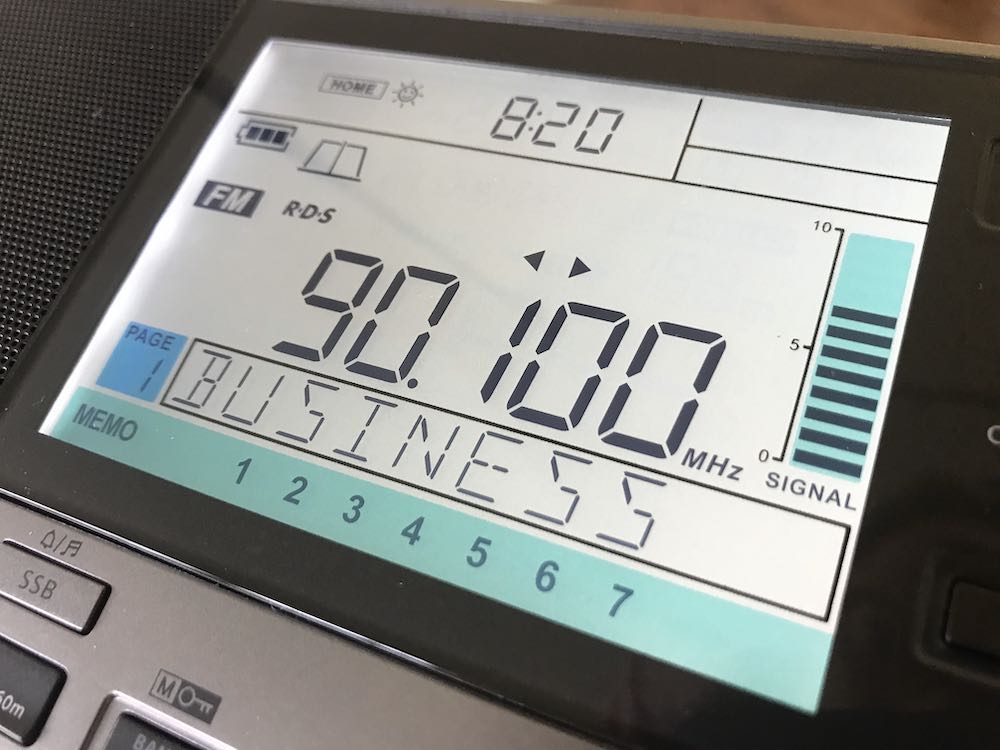 Sangean hits it out of the park with this multi-stage lighting for the display. Simply superb and the kind of quality we could only hope for from other manufacturers.
Sangean hits it out of the park with this multi-stage lighting for the display. Simply superb and the kind of quality we could only hope for from other manufacturers.
MAIN TUNING / DETENT CONTROL
I found the detents on the old 909x to be annoying – indeed, modifications have been available that could remove this feature. But Sangean being Sangean, the detent wheel remains in the 909×2 and it is not a deal killer.
AUDIO QUALITY
The radio retains the excellent audio of the 909x – I am not sure the 909×2 exceeds what one hears from a Tecsun 990x or H-501x but it’s right up there and competitive.
POWER SUPPLY
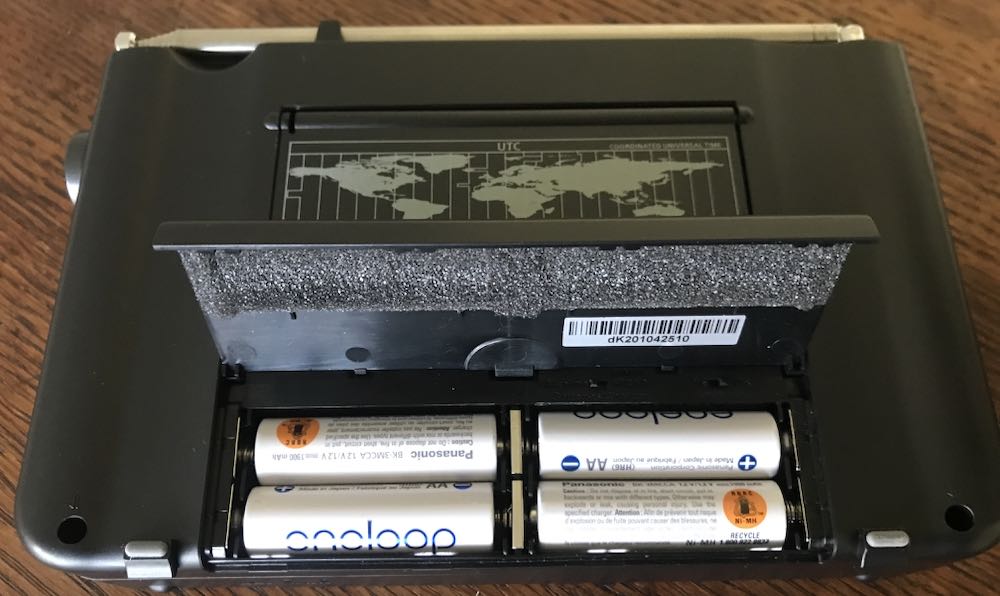 As others have noted, thanks to Sangean for sticking with AA cells. Together with internal charging when using Ni-Mh cells this is a major selling point. On the other hand – competitor Tecsun went a step farther with its H-501x which though it uses 18650 lithium batteries, has dual batteries, one of which can be held in standby, and switchable charging. That’s a design feature that you really have to respect.
As others have noted, thanks to Sangean for sticking with AA cells. Together with internal charging when using Ni-Mh cells this is a major selling point. On the other hand – competitor Tecsun went a step farther with its H-501x which though it uses 18650 lithium batteries, has dual batteries, one of which can be held in standby, and switchable charging. That’s a design feature that you really have to respect.
VARIABLE RF GAIN
Again, as noted by others Sangean retained the extremely useful thumb wheel RF gain control. This is an excellent feature.
KEYPAD
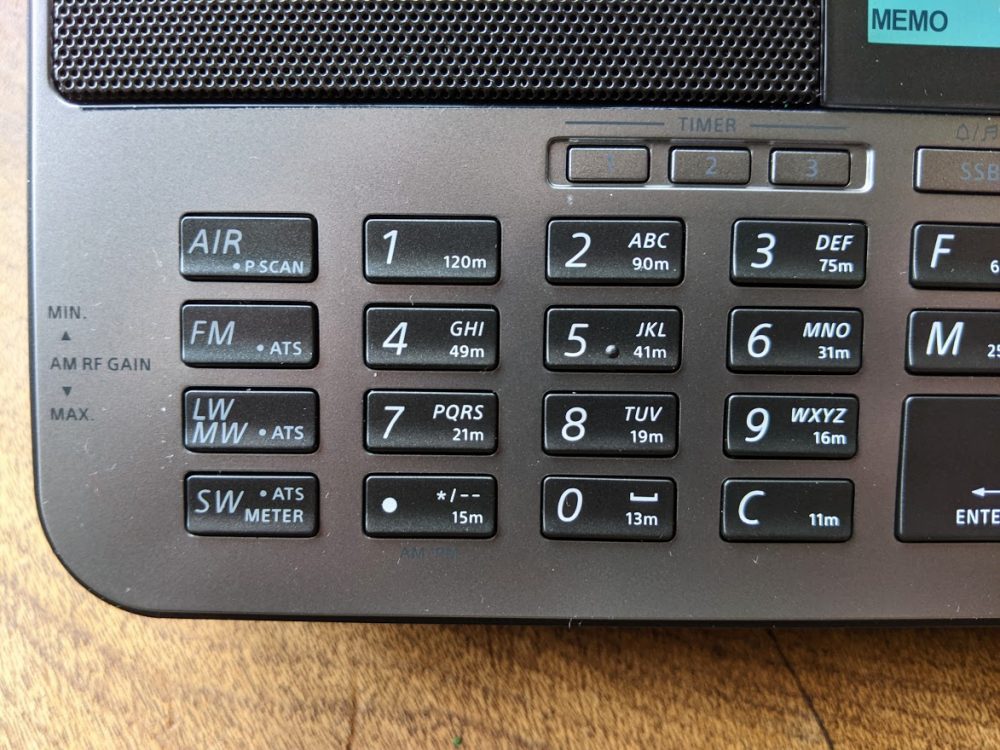 Another home run for Sangean when it comes to the keypads on the 909×2, which can be compared in this respect to the Tecsun H-501x which itself improves upon the 990x when it comes to front panel control. Time will tell, however, and we shall see if the keys on these radios hold up in heavy use.
Another home run for Sangean when it comes to the keypads on the 909×2, which can be compared in this respect to the Tecsun H-501x which itself improves upon the 990x when it comes to front panel control. Time will tell, however, and we shall see if the keys on these radios hold up in heavy use.
UP/DOWN SLEWING
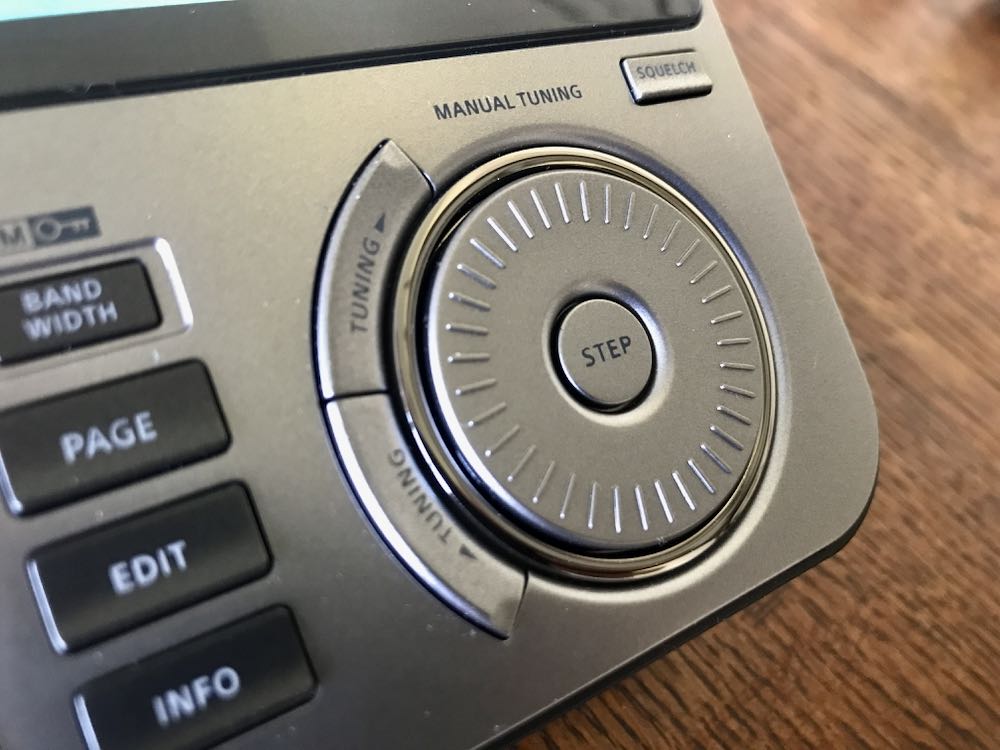 These controls which sit outside the circular main tuning knob are excellent, and reminds one of the slewing buttons on the SONY 7600GR, SW1000T and SW100.
These controls which sit outside the circular main tuning knob are excellent, and reminds one of the slewing buttons on the SONY 7600GR, SW1000T and SW100.
S-METER / DISPLAY
RSSI and SN Digital Signal Strength Information are provided on the beautiful 909×2 display. This is an improvement over the Tecsun signal strength/SNR meters that I wish would be redesigned, if in fact Tecsun has any intention of future modifications to their portables.
NO SOFT MUTING
Thank goodness we don’t have to deal with the annoying soft muting issue that is still seen in some other portables (the XHDATA D808 comes to mind along with the Eton Executive). Soft muting quite simply ruins a listening session and it’s baffling that any manufacturer still puts it in.
NEGATIVES (I AM IN TEARS)
OK, close all airtight doors and prepare to dive! Here are the negatives I see with the 909×2. I held off obtaining one of these radios because I knew there would be issues. And I was disappointed enough in the past with the 909x and 909 before it that I had almost decided not to go for it.
SIGNS OF LONGWAVE RECEPTION PLAGUED BY CROSS-MOD FROM MEDIUMWAVE
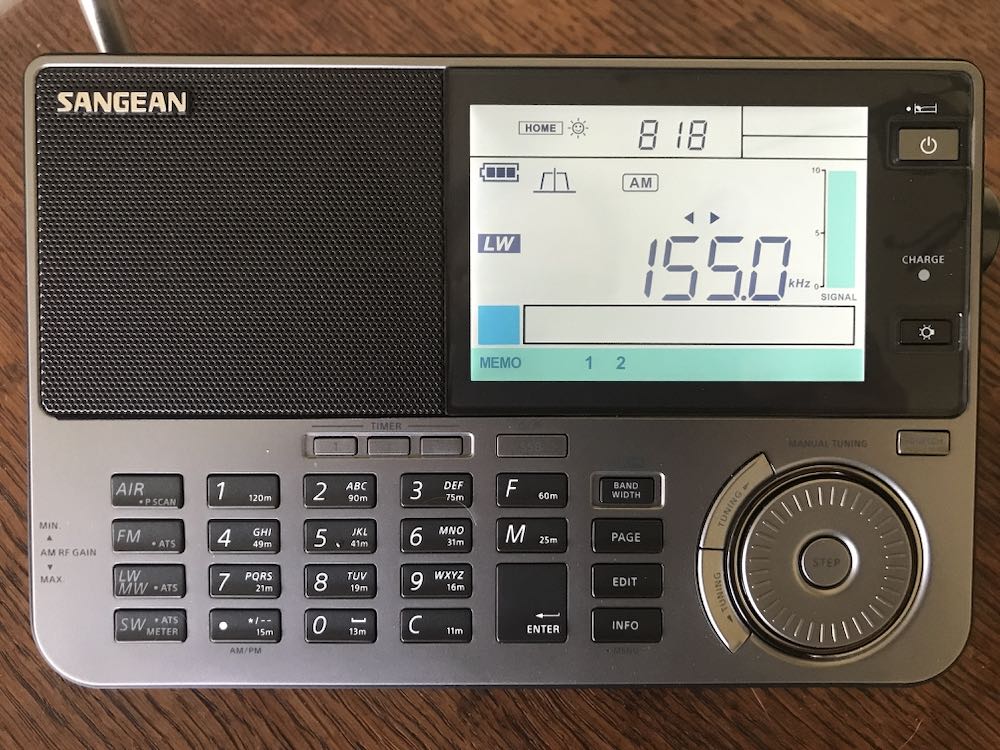 On my particular unit – it remains to be seen whether this is true for others – long wave seems to be near useless. The band is filled with mediumwave stations bleeding through. Turning down the RF obviously helps but I still hear AM stations here in the DC area, when I am in LW mode.
On my particular unit – it remains to be seen whether this is true for others – long wave seems to be near useless. The band is filled with mediumwave stations bleeding through. Turning down the RF obviously helps but I still hear AM stations here in the DC area, when I am in LW mode.
SSB PERFORMANCE
ALERT FOR SANGEAN AND ALMOST A DEAL BREAKER – as mentioned in the Zantow review, and in other comments I have seen on the 909×2, the drop in level from AM to LSB is a killer negative.
This is less noticeable in MW. But if you are in shortwave and have turned your volume up on any particular station, say a strong one such as Greece on 9,420 kHz or Spain, or an AM station, and you then switch to LSB it is like you have almost lost the signal. This simply needs to be fixed. Level on USB seems fine and acceptable, but LSB on shortwave requires immediate upwards adjustment of volume, only to have to reverse the process when returning to AM mode. I find this problem to be sufficiently serious that I would recommend against obtaining a 909×2 until Sangean finds a way to fix it. This issue is on the same level of BAD as the still unsatisfactory SYNC mode in all three of Tecsun’s shortwave portables. In fact, I may return the 909×2 I obtained and wait until a fix for this emerges.
Example Video
In this video, I demonstrate the extent of the problem as seen on this particular unit of the 909×2, which carries a serial number dk201043181.
Dave Zantow says his unit does not have this issue, so there is a possibility this is due to unit to unit variation. As you can see, with a strong signal such as 12,160 kHz — switching from AM to LSB instantly reduces listenable level, and signal as measured on the 909×2 drops to zero bars or near zero. In USB, the reduction is less severe. Regardless, having to perform adjustments with main volume just to struggle to hear any signal in SSB is a bit ridiculous. This kind of thing is not seen on the Tecsun H-501x or 990x though as Dave correctly points out, Tecsun receivers are not exactly great performers in SSB. On Tecsun receivers, there is a slight processor pause while the receiver makes the switch into LSB or USB, without the sharp reduction in listenable level.
CALIBRATION ISSUES WITH NO WAY TO ADJUST
Imagine my joy when I first began using the x2. Initially, it seemed to be smack on frequency – I tried this on WMAL, the powerhouse local AM station here in the DC area, and then again with stronger stations on shortwave, such as 12,160 kHz. Ah, I said to myself, Sangean has some decent QC and paid attention. About 30 minutes later, however, what I found matches the Zantow review. Stations are consistently low of the tuned/displayed frequency by as much as 300 Hz. The reason this is so disappointing is that I feel Sangean could have taken a clue from Tecsun and provided a re-calibration function (unless it exists and we aren’t being told about it). On Tecsun radios, the re-calibration capability is the major counter-punch to poor synchronous mode – in my view, one can live with flawed SYNC on a 990x or H-501 or PL-330 as long as you can adjust and at least have zero beat or close to it across frequencies. At the same time, as Zantow points out, no one should be expecting TCXO level performance from portables such as these. However, it is a bit disappointing that after all these years and redesign of the 909x to add some really nice features, they’re still landing up to 300 Hz from a tuned frequency. On the other hand, is this really any worse than one would see from an off-tuned SONY ICF-2010? No, and adjusting those older receivers required surgery.
CONCLUSIONS
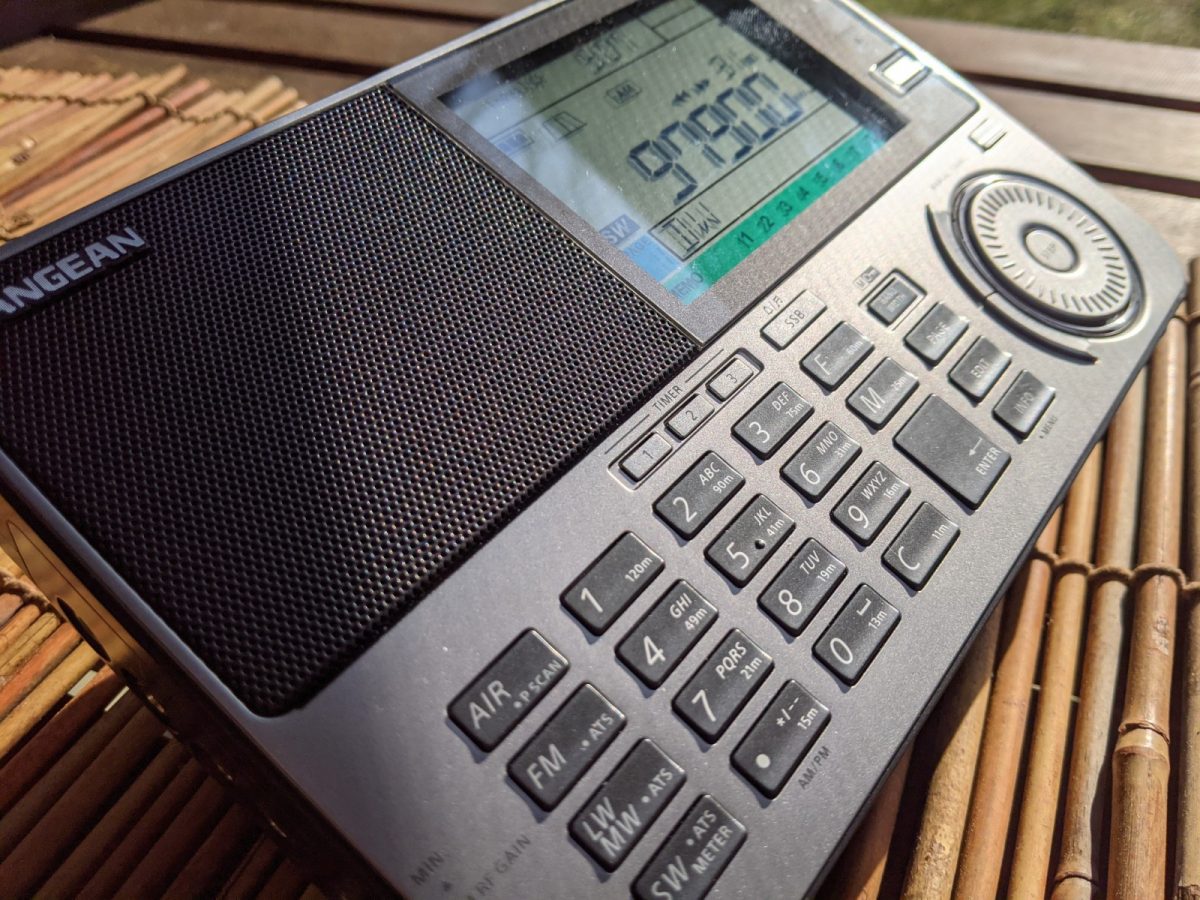 I really like the 909×2. There simply is something about this design that Sangean knew was a winner when it first arrived on the market years ago, so it’s not surprising that Sangean stuck with it. It’s clear that some hard thinking went into the step up from the old 909x, notably the larger LCD, addition of finer step tuning to make SSB easier, the robust antenna and the still pretty darn good audio through the wonderful speaker. The 909×2 is a radio that you can imagine guests would comment on if it were sitting on your coffee table – it just looks THAT GOOD.
I really like the 909×2. There simply is something about this design that Sangean knew was a winner when it first arrived on the market years ago, so it’s not surprising that Sangean stuck with it. It’s clear that some hard thinking went into the step up from the old 909x, notably the larger LCD, addition of finer step tuning to make SSB easier, the robust antenna and the still pretty darn good audio through the wonderful speaker. The 909×2 is a radio that you can imagine guests would comment on if it were sitting on your coffee table – it just looks THAT GOOD.
But then here in 2021, so does a Tecsun H-501x LOOK THAT GOOD. As I noted above, where the Tecsuns fall down – with their still challenged synchronous mode – they make up for with the ability to re-calibrate.
That is a huge feature and one that Sangean struck out on, though surely Sangean designers had to know the 909×2 would appeal both to listeners and to hobbyists with obsessions about frequency accuracy.
To repeat, I really (really) like the 909×2. But another area where the receiver strikes out is the problem with sharp reduction in LSB mode. Seriously – you have to crank the volume control up to at least 50 percent to hear ANYTHING when you’re in LSB, whereas USB requires going only up to about 30 percent. Then when you’re completing your carousel back to AM, you have to be sure not to still have the audio up at 50 percent or more to avoid blowing your speaker.
Again, as I said above, the calibration/drift issue on the 909×2 can be lived with. The problem with LSB, in my opinion, cannot or should not be tolerated. So, the question is, do you want to purchase a 909×2 now that still has that LSB audio issue, or wait a while until Sangean gets its act together?
These and other earthshaking questions are before us here in 2021. We have some of the best portables ever made by anyone in a time of sharply declining shortwave use, but they each have their flaws.
I don’t usually do a star rating or RECOMMEND / NOT RECOMMEND for radios. This time, I am going to make an exception and it links directly to the issue of the LSB problem on the 909×2. These radios simply should not have been allowed to enter the market with this being as serious a problem as I think it is. For that reason, I honestly cannot recommend a Sangean 909×2 until this is corrected.

I would like to point out the meaning of SINGLE Side Band (SSB). An AM signal consists of a carrier and two side bands, Upper and Lower. As the carrier contains no information and wastes energy, it can be suppressed and the signal reconstituted with a beat frequency oscillator (BFO).In Ham radio SSB only one side band is transmitted, Lower side band for 40 m and longer, and Upper side band for 20 m and shorter. I believe 31 m may use either. So if Greece is transmitting SSB on the USB, there is no LSB to receive.
two years later; I had the origina 909, it was a good radio I used to listen to SW broadcast when on holidays and NDB on longwave; longwave reception was excellent, here in Berlin (Germany) i could here with good signal all the NDB’s 30-40 km away from home;
now I bought the 909×2, it’s awful; I can not even understand how such a bad designed product can be sold; SSB is useless, and I do not think it’s just a loudness problem, it’s a sensitivity one; SW inside home is useless, no signals at all, but a lot of noise: my 50 year old Kenwood receiver doesn’t pick those noises, and can hear some ham stations, the Sangean is deaf;
audio quality is bad, it seems that all AM signals are in some way digitally processed, the sound is never clear, it’s always “dark”, confused;
with a 1969 Sony portable MW radio I stil can hear a good number of stations, the Sangean – again – is deaf: nothing; the same is true for longwavve and AirBand;
FM works fine;
selling half-working stuff is quite normal today, but I think customers should not accept this way of trading; if I buy a SSB radio, SSB must work; even the AirBand converter (AirBand to mediumwave) sold in UK airports in the Seventies had better reception than this stuff;
thank you for reading, Andrew here, 50 year long ham operator;
Sounds like you have a faulty unit. Sangeans quality control went downhill when they shifted manufacturing away from Taiwan. I’ve had two Sangean DAB+/MW/FM receivers which both developed a faulty DAB+ tuner. Even one of their “outback” radios developed a faulty display.
By comparison, I have four different versions of the original ATS-909 which are still working superbly. Overall though, the ATS-909X and ATS-909X2 are a disappointment in SSB sensitivity and dynamic range. The original ATS-909 has a very robust front-end for a portable and is still unmatched by any modern portable SW receiver in this department.
Mine is a March 2022 build date.Really a great radio.I’ve had or own or used about all of the newest model’s.Yes the one bandwith in SSB is weird but hey its so clear and low noise floor i really cant beat it with a unit that has multiple bandwiths in SSB.and i usually find the best voice clarity on other units are 2.4 to 4.0 at end of day.But the Sangean has such a low noise floor in SSB I can dig weak signals out clearly.I almost think the drop In volume while in SSB is due to the fact there’s more going on than a simple bandwith filter.It feels like Noise reduction is also activated.On a side note on mine with an external antenna which boost the signal there’s hardly any volume loss between AM and SSB.People saying some have volume loss and some dont are probably using external antennas and some not.Also if using AC supply I dont see volume drop.only on batteries and whip combo do I see volume drop on SSB.I have a proper late build date(July 03) Grundig Sattelit 800 that’s perfect in every way and the Sangean909x2 is better on SSB clarity.And my portable of choice for last couple of years was a Tecsun S-8800 very sensitive unit on SW bands.the Sangean is as good but way better audio clarity on SSB with external antennas.the S-8800 sort of gets too messy sounding on a longwire but the Sangean it just comes alive on a Longwire.Also the antenna jack on the Sangean is 50-ohm.Great for magentic loops but if doing a longwire go straight to whip with clip you can get 3 or 4 more S units out of the signal.It’s a fine radio after 40 years of using SW receivers I feel its a classic unit that will be in demand in years to come.
Just to note, my 1990s original Sangean ATS909 has lower volume on both LSB and USB. I’ll assume this has carried through all models of the Sangean line up from the 1990s to current models.
Well that may be the case, but Sangean should wake up and smell the flowers when it comes to this issue — there is no reason for the volume difference in SSB seen on many 909×2 receivers.
Mine loved to be spank.. receive goes on and off when being tap. Looks like a quality control issue. Had it replaced. Whip antenna is loss that wiggles and not sturdy. Though the ssb rx does not have proper bandwidth settings but you can use the tone settings. They said the whip is weak.. NO, listen to the weak signals and set the tone to mid.. youll hear them.. i compared it to my PL880 my icom 7610 and this receiver rocks! Its receive is awesome even on weak signals. The whip is better than my dipole antenna or 6BTV antenna which are outdoor. Its even more better when you use MLA-30+ loop antenna.. more clearer receive. For the video of my 1st amazon purchased see my amazon review. This radio is a keeper and planning to return my Tecsun PL880. Only complain is, it eats juice faster, a bit heavy, a loss whip antenna is not fixable even you tighten the 3 screws inside.. no SSB bandwidth option.. just narrow.
Hi Dan, just wondering if any info has come back from Sangean yet about these issues with the ATS 909X2 073 version? thanks!
Fellow DC area resident here, who enjoys Dulles Apt Air Band, so is considering this.
There are reports on the success of the 073 firmware on the SSB volume issue. Was yours 070?
Read my review. 073 firmware
Hi Dan,
Mine, running FW070, does not exhibit this SSB volume issue. There appears to be a sample to sample variation at play here. I must say that I enjoy this little radio!
Noel
I would definitely find the sharp drop in volume when switching to LSB very annoying! However, I am impressed at the wide range of available bandwidths.
Thanks for the honest review. I enjoy a couple of different Sangean AM/FM radios that are very highly rated. Strange that Sangean would go out of their way to improve the tuning resolution on SSB from 40hz down to 10hz, yet have the LSB volume drop to near useless as well as not have multiple bandwidths. Arguably, LSB is the mode most used on amateur bands. And not having Sync makes one need a fully functional LSB for digging out signals with adjacent channel interference. Can’t seem to trust anyone’s design making it to a usable product these days. I think I will stick with the AirSpy SDR I have for now. It might even be cheaper to buy a second knock-around computer to use in the field with the Airspy!
The level drop in SSB been a “feature” in the Sangean ATS line for a long time; it was slight but noticable (compared to equivalent radios of the time) with the original ATS-803, and every model with SSB since has suffered from it to varying degrees.
If they haven’t fixed it in multiple models over the last 35 years, I wouldn’t recommend anyone hold their breath waiting for a firmware upgrade to fix the 909X2.
Beste mede radioluisteraars, mijn Sangean ats 909×2 heeft dat probleem met de LSB ook. Dat moet gewoon door Sangean worden opgelost. Overigens ben ik zeer tevreden mijn mijn zwarte ats 909×2. Het geluid is fantastisch. Ik heb ook een Sony sw 100. Een fantastisch kleine radio.
Sony had zeer goede kortegolf radio’s. Bijna niet te evenaren.
Thanks — you are a member of the classic SONY portable fan club, which for me includes SW100S, SW-77, ICF-2010, SW-07, ICF-7700, ICF-SW55, etc etc etc
Ok, stick with me on this. I use SSB routinely to listen to weak AM stations, even in lieu of effective synchronous detection. Yes, the volume is lower, not just on my older 909X, but on all the Tecsuns and Sonys I own. I don’t think its either a fault or a feature, but rather inherent in the complex detection processing going on inside these radios. Don’t just listen for volume. See if you don’t think the signal+noise-to-noise ratio, i.e., sensitivity isn’t somewhat better on SSB. Of course, you have to consider the respective bandwidths of each detection mode. Bottom line: Adjusting the volume when going from AM to SSB and back is a matter of fact regardless of the radio – something you tolerate if you’re going for DX.
Bob C.
Tecsun 909x, 501x, even the 330 don’t have this steep level loss when
switching to SSB. Understand the basic theory but this stands out like
a sore thumb. On the other hand, it does appear that on one video
another x2 did not have as serious an issue, so this could well be a sample
to sample issue.
“Be not the first by whom the new are tried, Nor yet the last to lay the old aside.”
– Alexander Pope
A lesson I learned some years ago with the then new Tecsun PL-880.
Bob C.
Disappointing that Sangean might have a minor QC issue on their hands. I’m sure they’ll figure it out. They do seem to be trying with firmware upgrades.
I’ll beat the drum again. Buy from Amazon directly if you can. Easy returns with no restocking fees.
Every version of the Sangean ATS-909 series has low audio on SSB! It’s a feature – not a fault and the degree of audio variation differs with manufacturing.
Asking Sangean to fix something that isn’t a fault is crazy. If you want louder audio on SSB then hook up an amplified speaker.
Well, you’re entitled to your opinion but this is not a necessary feature and sharply detracts from the operation of the radio.
I don’t see the low volume as a design feature.
No way was a Sangean engineer thinking that during the reception of a signal in SSB, I’ll have the listener rip the volume knob off .
Listening to anything in LSB requires me to either make the room I’m in completely quiet or grab a pair of headphones that are more expensive than the radio itself. Not good for a portable unit.
It’s not enough at this point for me to return my X2 but I’m only 3 days in on owning it. My opinion seems to wavering on whether I might return my unit. Put me in the “keep it but small annoyances keep popping up” camp. I’m still waiting on some adapters to see how the X2 will do with some external antennas. This is why I buy from Amazon. There’s no rush.
As an aside, the X2 last night was nothing short of stunning on FM yet again. I managed to snag a LPFM station transmitting at 10W (so says Radio Locator) from roughly 84 miles away. Was it down in the weeds? Yup. Enough for an ID? You betcha. Worthy of shouting out? Yes, yes, and yes.
The drift issue is quite interesting. I have one of the pre-production units shipped to Europe, and I haven’t noticed any drift. I used the radio outside in low temperatures, and it was stable.
Could you tell us what were the temperatures when you experienced drift? Since you mentioned 30 minutes, I’m suspecting that the radio might experience more significant drift when it’s heating up.
On batteries — this one went from being almost on zero beat to anywhere from 40 to 200 hz below zero beat, on SW.
Thanks for another tell-it-like-it-is, honest review, Dan. The volume level issues between AM/LSB/USB is the #1 reason I returned my ATS-909X2 (firmware 070). I was hoping the new 073 firmware would resolve this annoying problem!
You didn’t mention any problems with MW on your unit, but I’m wondering if you notice any RFI hash or buzzes layered on top of any of the 10 kHz channels? Mine had a few, and the interference was loud enough to obliterate moderately strong stations beneath… stations which were perfectly clear without interference on other simpler (lower cost!) radios I own. This was not locally generated QRM, but interference from the 909X2’s own circuitry (and NOT related to the LCD screen interference & hand capacitance issue, which my 909X2 also had on some shortwave bands).
The new 909X2 hits a home run in so many respects, including build quality and design. It’s real shame to have its performance so hampered by the LSB/USB audio drop and various self-inflicted noises.
In your video you tune in a strong station on 12160 kHz. I’m sure you’ve observed the audio drop problem is even worse if you are tuning a weaker, DX level station and trying to improve reception with ECSS (LSB/USB on an AM signal). If the signal isn’t strong enough in AM to begin with, switching to LSB or USB can leave you with *nothing* on the frequency! What were the Sangean engineers thinking? Don’t they ever use their receivers in real world, SWL or DXing conditions? I have my doubts now that this audio issue can ever be solved with a firmware update.
Thanks Guy for that comment which just reinforces my observations. Dave Zantow agrees, having seen the video update on this review. My 909×2 is heading back to Amazon/Sangean. Before I did that, I brought out my 909x and H-501x receivers just to make sure of the points I was making on the Sangean. Yes, the Tecsun receivers have annoying SSB performance, and still challenged SYNC, but those are offset to a great degree by great sensitivity, bandwidths avialable in SSB, and re-calibration capability.
I’ll be adding this video to the review, which shows how serious this issue is on the 909×2. A side by side comparison just now with the Tecsun 909x shows that the Tecsun recovers audio level decently and does not have this sharp drop in level.
https://youtu.be/yXHmd_p436I
I had the previous iteration of this radio and was amazed at how bad the longwave band was. Full of MW images, just as you note. True there isn’t much on LW but I like to chase airport beacons. Why include it If it’s not usable?
As I note, turning the RF gain down helps. Inclusion of LW, as the Tecsun radios also have, is strange considering that there is almost no more use of longwave these days. More important in my view is the LSB level issue.
So how does the Sangean ATS-909X2 compare to the Realistic DX-440/
Sangean acts 803A, Sony Icf-2010? …eg AM/MW sensitivity, selectivity?
Well,you can still go with one of these:
http://www.wb9kzy.com/lfconv.htm